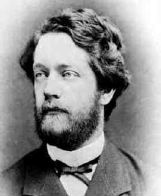

Klein attended the Gymnasium in Düsseldorf. After graduating, he entered the University of Bonn and studied mathematics and physics there.
He started out with the intention of becoming a physicist, but as a laboratory
assistant to Plückerchanged his mind. Klein received his doctorate, supervised by Plücker, in 1868. In his dissertation Klein classified second degree line complexes using Weierstrass's theory of elementary divisors.
Later that year Plücker died, leaving his major work on the foundations of line geometry incomplete. Klein was the obvious person to complete the second part of this work. For a short period, he did military service as a medical orderly before being appointed as a lecturer at Göttingen in early 1871.
Klein was appointed professor at Erlangen in 1872, at the remarkably early age of 23. He took a chair at the Technische Hochschule at Munich in 1875. Among the students that Klein taught
while at Munich were Hurwitz, von Dyck, Rohn, Runge, Planck, Bianchi and Ricci-Curbastro.
After 5 years in Munich, Klein was appointed to a chair of geometry at Leipzig. There he had as colleagues a number of talented young lecturers, including von Dyck, Rohn, Study and Engel.
His career as a research mathematician essentially over, Klein accepted a chair at the University of Göttingen in 1886. There he taught a wide variety of courses, mainly on the interface between mathematics and physics, such as mechanics and potential theory. He taught there until he retired in 1913, and he then sought to re-establish Göttingen as the foremost mathematics research center in the world.
The fame of the journal Mathematische Annalen is based on Klein's mathematical and management abilities. Only under Klein's management did it first rival, and then surpass in importance, Crelle's Journal. The journal specialised in complex analysis, algebraic geometry and invariant theory. It also provided
an important outlet for real analysis and the new area of group theory.
It is a little hard to understand the significance of Klein's contributions to geometry, since
so much a part of our present mathematical thinking that it is hard for us to realize the novelty of his results.
Klein's first important mathematical discoveries were made in 1870 in collaboration with Lie. They discovered the fundamental properties of the asymptotic lines
on the Kummer surface. Further collaboration with Lie followed and they worked on an investigation of W-curves. In 1871 Klein published two papers on non-euclidean geometry
in which he showed that non-euclidean geometry was consistent if and only if euclidean geometry was consistent. This put on non-euclidean geometry an identical footing to euclidean geometry.
Klein's synthesis of geometry as the study of the properties of a space that are invariant under a given group of transformations, known as the Erlanger Programm, gave a unified approach to geometry which is now the standard accepted view. Transformations play a major role in modern mathematics and Klein showed how the essential properties of a given geometry could be represented by the group of transformations that preserve those properties.
However Klein himself saw his work on function theory as his major contribution to mathematics.
By considering the action of the modular group on the complex plane, Klein showed that the fundamental region is moved around to tessellate the plane. He wrote a paper in 1882 which treats function theory in a geometric way connecting potential theory and conformal mappings. He also used physical ideas in this work, especially those of fluid dynamics.
Klein considered equations of degree greater than 4 and was particularly interested in using transcendental methods to solve the general equation of the fifth
degree. After building on methods due to Hermite and Kronecker, producing similar results to Brioschi, he went on to completely solve the problem using the
group of the icosahedron. This work led him to consider elliptic modular functions which he studied in a series of papers.
He developed a theory of automorphic functions, connecting algebraic and geometric results in his important 1884 book on the icosahedron. With Robert Fricke who came to Leipzig in 1884, Klein wrote a major 4 volume classic on automorphic and elliptic modular functions produced over the following 20 years. Another project he worked on around the turn of the century was the Enzyklopädie der Mathematischen Wissenschaften. He took an active part in this project,
editing with K. Müller the 4 volume section on mechanics. We should also mention the Klein bottle, a one-sided closed surface named after Klein.
Starting in 1900 he began to take a lively interest in mathematical instruction below the university level while continuing to pursue his academic functions. An advocate of modernizing mathematics instruction in Germany, in 1905 he played a decisive role in the introduction in secondary schools of the rudiments of calculus and the function concept. Klein was elected chairman of the International Commission on Mathematical Instruction at the Rome International Mathematical Congress of 1908. Under his guidance the German branch of the Commission published many volumes on the teaching of mathematics at all levels in Germany.
Klein was elected a member of the Royal Society in 1885 and received the Copley medal of the Society in 1912.